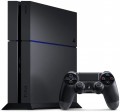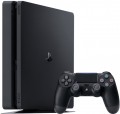Release year
The official release year of the game console. Usually, it is indicated by the date of official sale. This information allows you to determine the "age" of the device — and, accordingly, its functionality (to some extent), including within its own platform. So, for example, the difference between the Xbox One S and Xbox One X in terms of name is not particularly obvious; but knowing that the first was released in
2016, and the second —
in 2017, you can definitely determine which model will be newer and more advanced. Accordingly
, the novelties of 2020 and
2019 will be even better.
Communications
— LAN (Local Area Network). The most common and in fact the dominant interface today for wired connection of various electronic devices to computer networks. Allows you to work with local resources, as well as access the Internet. In the case of game consoles, such a connection can be used for network games, for working with specialized gaming services, cloud storage, firmware updates, and even for full-fledged web surfing and/or playing music and videos from local resources or Internet sites; specific network capabilities in different models are different. Note that the LAN interface is installed exclusively in desktop consoles (see "Form factor") — it is poorly suited for portable ones for a number of reasons.
— Wi-Fi 4 (802.11n). Game consoles use
Wi-Fi wireless technology primarily to access the Internet. The ways of using such a connection can be different: multiplayer games, access to branded gaming services, social networks, full-fledged web surfing, updating games or firmware, etc. This method of connection is more convenient than wired, because it eliminates the hassle with cables; and for portable models (see "Form factor"), it is actually the only possible one. Specifically, the Wi-Fi 4 (802.11n) standard provides data transfer rates up to 300 Mbps and uses two bands — 2.4 GHz and 5 GHz. The latter ensures compatibility with both earlier (Wi-Fi 802.11 b/g) and later (Wi-Fi 5) standards. And the mentioned speed is consider
...ed relatively low, but for most tasks it is more than enough.
— Wi-Fi 5 (802.11ac). Further, after the Wi-Fi 4 described above, the development of Wi-Fi technology. It uses the 5 GHz band and gives a data transfer rate of more than 1 Gbps (in the future — up to 6 Gbps). This speed not only simplifies the transfer of large amounts of data (for example, downloading games or updates to them), but also reduces lag in online games. For compatibility with older Wi-Fi standards using the 2.4GHz band, Wi-Fi 4 may also be supported in addition to Wi-Fi 5.
— Wi-Fi 6 (802.11ax). The latest version for 2020 uses the ranges from 1 to 7 GHz — that is, it is capable of operating at standard frequencies of 2.4 GHz and 5 GHz (including with equipment of earlier standards), and in other frequency bands. The maximum data transfer rate increased to 10 Gbps, however, the main advantage of Wi-Fi 6 was not even this, but further optimization of the simultaneous operation of several devices on the same channel (improvement of the technical solutions used in Wi-Fi 5 and WiGig). Thanks to this, Wi-Fi 6 gives the smallest speed drop among modern standards when the channel is loaded.
— Wi-Fi 6E (802.11ax). The Wi-Fi 6E standard is technically called 802.11ax. But unlike basic Wi-Fi 6, which is named similarly, it provides for operation in the unused 6 GHz band. In total, the standard uses 14 different frequency bands, offering high throughput in the most crowded places with many active connections. And it is backwards compatible with previous versions.
— Wi-Fi 7 (802.11be). As in the previous edition of Wi-Fi 6E, the technology supports operation in three frequency ranges: 2.4 GHz, 5 GHz and 6 GHz. Wi-Fi 7 bandwidth has increased from 160 MHz to 320 MHz, allowing larger amounts of data to be transferred overnight. IEEE 802.11be uses 4096-QAM modulation, which also allows more symbols to be accommodated in a data transmission unit. The maximum you can squeeze out of the standard is up to 46 Gbit/s information exchange speed. In the context of game consoles, the development of MLO (Multi-Link Operation) looks like a useful innovation, with which you can aggregate several channels in different ranges. This significantly reduces delays in data transfer, while simultaneously ensuring low and stable ping in games. And when connecting multiple client devices, Multi-RU (Multiple Resource Unit) technology is designed to minimize possible delays.
— Bluetooth. Wireless interface designed for direct connection between various devices; very versatile and can be used for a variety of purposes. In game consoles, use cases for Bluetooth include connecting wireless controllers, headphones and headsets, and sharing files with other gadgets (such as a laptop or tablet); the specific capabilities of this interface are different in different models. Bluetooth uses the radio range and has a range of about 10 m, while it can maintain a connection even through walls (except that the range in this case is reduced).
— NFC. NFC (Near Field Communication) is a wireless communication technology with a short range, of the order of several centimeters. Potentially, it has quite extensive capabilities, but today it is most often used as an auxiliary tool when connecting via Wi-Fi or Bluetooth. If both connected devices have an NFC, instead of searching, connecting, authorizing and other actions, it is enough to bring these devices to each other and accept the connection. The vast majority of game consoles with an NFC are portable (see Form Factor).Connectors
—
mini-Jack (3.5 mm). General purpose connector, most commonly used as an analogue audio output. Simply put, in set-top boxes, such an interface is usually designed to connect headphones, speakers and other external audio accessories — a lot of such devices use a 3.5 mm plug, and there are corresponding adapters for other interfaces. At the same time, the specific functionality of the mini-Jack connector may be different. So, in some models it works only as an output, in others it can be used to connect a headset with a microphone or even a separate microphone. In addition, this connector can be combined with an optical S / P-DIF output (for more details, see "Additional").
— miniHDMI. A smaller version of the HDMI interface detailed below. It is installed in portable consoles and game pads (see "Form factor"), does not differ from the full-size version, except for the dimensions of the connector, and is used for the same purpose — to connect to a TV or other screen and transmit video and audio signals.
—
HDMI. A digital interface that allows you to simultaneously transmit high-definition video and multi-channel audio up to 7.1 over a single cable (in addition, in high quality and with a minimum of interference). It is one of the most common in modern video technology, the vast majority of TVs and monitors have at least one HDMI input. At the same time, for working with resolutions from
...HD (1280x720) and higher, this connection interface is considered optimal today. Therefore, the presence of HDMI is almost mandatory for desktop consoles with support for high-definition video (portable models do not use a full-size connector due to their relatively large dimensions).
— microUSB. A reduced (actually, the smallest to date) version of the USB interface, widely used in computer technology for connecting external devices; completely identical to the full-size version, except for the shape and dimensions of the connector. Appeared due to the fact that the original USB connector has rather large dimensions, poorly suitable for pocket-sized equipment; accordingly, among consoles it is usually found in portable models and gaming tablets (see "Form factor"). The microUSB connection is designed for the set-top box to work as a connected device, slave (for more details, see "USB 2.0"). With it, you can, for example, download new games to your device or update the firmware.
— micro USB (MHL). Connector that combines the capabilities of microUSB and HDMI (see above). It is completely identical in shape and size to microUSB, it is also compatible with a conventional USB interface and provides the same features; however, MHL can also be used for high-definition video and multi-channel audio. Such a transfer is provided through a simple adapter cable with a microUSB plug on one end and HDMI on the other; with this connection, the set-top box battery can even be recharged. MHL was created as a mobile standard and it is used, respectively, in portable models (see "Form factor"). It eliminates the need for manufacturers to provide a separate miniHDMI output for video output, which has a positive effect on compactness. However for normal operation in video transmission mode, it is necessary that the TV or other external screen also has MHL certification; however, in extreme cases, the situation can be corrected with a simple adapter.
— USB-C. A kind of USB connector, positioned simultaneously as a replacement for full-size USB and for compact microUSB. It is comparable in size to microUSB, which is why it is found mainly in portable and hybrid consoles (see "Form factor"). One of the features of this interface is a two-way connector that can be inserted into the socket by either side (unlike previous types of USB connector). In terms of purpose, USB-C is in most cases similar to microUSB; and in terms of data transfer speed and other characteristics, it usually corresponds to USB 3.0 or 3.1 (see below).Additional
Additional connectors provided in the design of the set-top box in addition to those described above. A set of such connectors may include, in particular:
— Proprietary ports for wired gamepads and other controllers.
— IR (IR) inputs and outputs to work with various wireless accessories.
— Digital audio outputs for multi-channel audio. The most popular standard for such outputs is S / P-DIF, it has two varieties — optical and coaxial. The optical output can be separate or combined with the Mini-Jack 3.5 mm output (see "Connectors"); its advantage is the insensitivity of the cable to electrical interference, but the cable itself is quite fragile and requires delicate handling. Coaxial (electrical) connections are not as sensitive, but are more prone to interference.
— Analogue audio and video outputs (AUX, composite, component) — these connectors can be useful for connecting outdated video equipment.

